The Harlem Renaissance Art the Harlem Renaissance Art Jazz
The Harlem Renaissance was a cultural nascence of new ideas and artistic expressions during the 1920s in the Harlem neighborhood in New York Urban center. It consisted of many disciplines similar visual arts, music, theatre, and literature. Rooted in the foundations of African American culture, artists sought to take a stand up for their independence, self-worth, and rightful identify in social club. Beneath nosotros explore this further and some of the well-known Harlem Renaissance artists.
Table of Contents
- 1 What Was the Harlem Renaissance?
- one.1 The "New Negro" Movement
- 2 Harlem Renaissance Artwork
- two.one Works Progress Administration (WPA) and the Harlem Artist'south Society
- 3 Major Harlem Renaissance Artists
- 3.i James Van Der Zee (1886 – 1983)
- 3.2 Augusta Savage (1892 – 1962)
- 3.iii More than Harlem Renaissance Artists
- four The African American Legacy
- five Frequently Asked Questions
- 5.1 When Was the Harlem Renaissance?
- 5.ii How Did the Harlem Renaissance Start?
- 5.3 What Was the Harlem Renaissance?
- 5.four What Was Harlem Renaissance Art?
- 5.5 What Were the Characteristics of Harlem Renaissance Art?
- five.6 What Did Harlem Renaissance Artists Express Through Sculpture?
What Was the Harlem Renaissance?
When we await at the Harlem Renaissance timeline, we volition see that it started during the tardily 1910s and early 1920s in New York Metropolis, around the end of World War I. It lasted until the 1940s, around the time of Earth State of war 2. Still, some sources indicate that it concluded around 1929, which was during the time of the Stock Market Crash that led to the Keen Depression in 1930. The Harlem Renaissance's origins lie in the events leading upwards to the Groovy Migration in Southern America around 1916.
Millions of blackness Americans migrated from places like Mississippi, South Carolina, and Louisiana to Northern American cities like New York, Los Angeles, and Washington D.C, among others. This was known as the Great Migration.
In that location were many factors that caused Black Americans to migrate, primarily the rise and unceasing racial segregations, lynching, and poor social and economic treatment of the African American communities in the Due south. The Jim Crow laws besides negatively affected any positive chances of betterment for the African American communities.
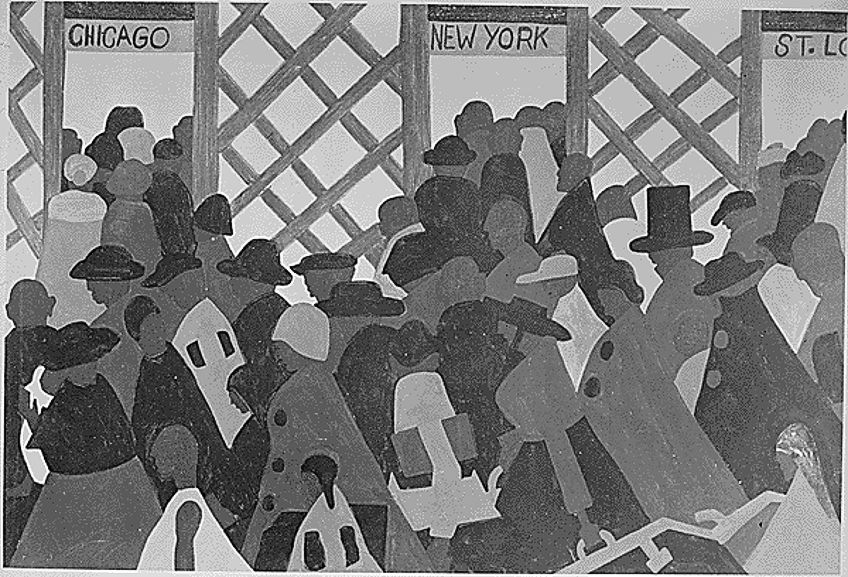 Console 1 from Migration of the Negro (1940-1941) by Jacob Lawrence;Jacob Lawrence (1917 – 2000), Harmon Foundation, Public domain, via Wikimedia Commons
Console 1 from Migration of the Negro (1940-1941) by Jacob Lawrence;Jacob Lawrence (1917 – 2000), Harmon Foundation, Public domain, via Wikimedia Commons
In that location were likewise new work opportunities from Northern cities. Many factories and other industries needed workmen because of World War I and the shortage of hands it created. This gave Black Americans the chance to detect new homes and establish themselves within the Northern urban areas. It also led to new cultural expressions within these communities.
White communities caused an uproar as a upshot of the Great Migration, resisting the move of African American communities to areas further north. In the Summertime of 1919, white veterans who had returned home from the war started attacking the black veterans who had besides served in the war.
This effect was called the Crimson Summer.
The attacks took place in diverse cities, with many African Americans (including women and children) beingness lynched and killed. Homes and businesses were burnt down and destroyed, and there was an overall surge of violence among the white communities to eradicate what they believed was a threat to them and the Jim Crow laws.
 Coverage of the Washington DC race riots, known equally Red Summertime, The Washington Times, 1919; The Washington times. July 22, 1919The Washington Times. July 21, 1919, File:Motorcycle involved in the Washington race riot of 1919.jpg, File:Richmond planet Newspaper Editorial Cartoon about race riots.jpg, File:Soldiers with Black Resident of Washington, D.C., 1919.png, Public domain, via Wikimedia Commons
Coverage of the Washington DC race riots, known equally Red Summertime, The Washington Times, 1919; The Washington times. July 22, 1919The Washington Times. July 21, 1919, File:Motorcycle involved in the Washington race riot of 1919.jpg, File:Richmond planet Newspaper Editorial Cartoon about race riots.jpg, File:Soldiers with Black Resident of Washington, D.C., 1919.png, Public domain, via Wikimedia Commons
When the black veterans who had served in the war returned dwelling, they had a new sense of personal ability and agency to stand up against racial injustices. This was undoubtedly regarded as a threat to the racial laws already in place.
The events from the Ruddy Summer compelled many African Americans to stand in unity as a culture. This is as well read in the poem written past famous Harlem Renaissance author, Claude McKay, titled, If We Must Die (1919). While the poem does not make a direct reference to any cultural or racial group, it remains a testament to solidarity.
Information technology was also considered the starting point of the Harlem Renaissance and its values of justice and equality.
The "New Negro" Movement
Alain LeRoy Locke was born in Philadelphia and was an important writer, philosopher, educator, and fine art patron during the early on 1900s. He is well-known for having created the theoretical framework for the Harlem Renaissance and everything it stood for. He is often described as beingness the "Dean" of the Harlem Renaissance.
Information technology started when he wrote the article titled Harlem, Mecca of the New Negro (1925) for the Survey Graphic magazine in America. The article was an informative and educational exploration of the African American culture based in Harlem.
This article led to Locke producing and co-writing an album with several more essays, fiction pieces, and poems about this burgeoning culture in what was titled The New Negro: An Interpretation. It included the following essays:Forward, The New Negro, Negro Youth Speaks, The Negro Spirituals, and The Legacy of Bequeathed Arts.
 Comprehend of The New Negro: An Interpretation (1925) past Alain Locke; Alain Locke, Public domain, via Wikimedia Commons
Comprehend of The New Negro: An Interpretation (1925) past Alain Locke; Alain Locke, Public domain, via Wikimedia Commons
Some of the writers who co-wrote with Locke included Claude McKay, Countee Cullen, Eric Walrond, Jean Toomer, Langston Hughes, and Zora Neale Hurston. The abovementioned writers were all multi-talented novelists, playwrights, poets, columnists, and journalists, amid others. The anthology was a milestone in the cultural development and evolution of the African American community.
It explored themes based effectually cocky and social sensation, identity, solidarity as a customs, and the strength inherent in African American people regardless of the atrocities and injustices that they experienced over the decades.The New Negro as well expanded on the concepts of "Old Negro" and "New Negro", exploring the differences between the two and how the latter had been revived in Harlem. Indeed, the culture of the "New Negro" went through a rebirth of sorts, hence a Renaissance in Harlem.
This rebirth brought on new forms of self-expression and freedom from slavery, oppression, and the limiting constraints of the Jim Crow laws put in place.
Locke describes this rebirth as a "spiritual emancipation" and uses the analogy of "shedding the old chrysalis". Furthermore, The New Negro was nearly like the manifesto for the Harlem Renaissance motility.
 An image past Aaron Douglas from Alain Locke's The New Negro: An Interpretation (1925);By Alain Locke, Public Domain, Link
An image past Aaron Douglas from Alain Locke's The New Negro: An Interpretation (1925);By Alain Locke, Public Domain, Link
Before Locke's introduction of The New Negro, there were of import figures within the African American community who had laid the foundations of discourse on oppression and racism in African American communities. Some of these figures include Booker T. Washington and Hubert H. Harrison.
W.E.B. Du Bois was also an of import figure, existence an activist, socialist, and author. His main contributions were in the Civil Rights movements and interim against the racial oppressions from Jim Crow laws and lynching, and he sought to educate all about African independence and equality.
Harlem Renaissance Artwork
Harlem fine art stands for all things to do with the Harlem Renaissance and its expression. Artists expressed themselves in a wide multifariousness of modalities, namely, theater, film, poetry, literature, music like Jazz and the Blues, and the visual arts similar painting in the form of murals, sculpture, photography, printmaking, and book illustrations.
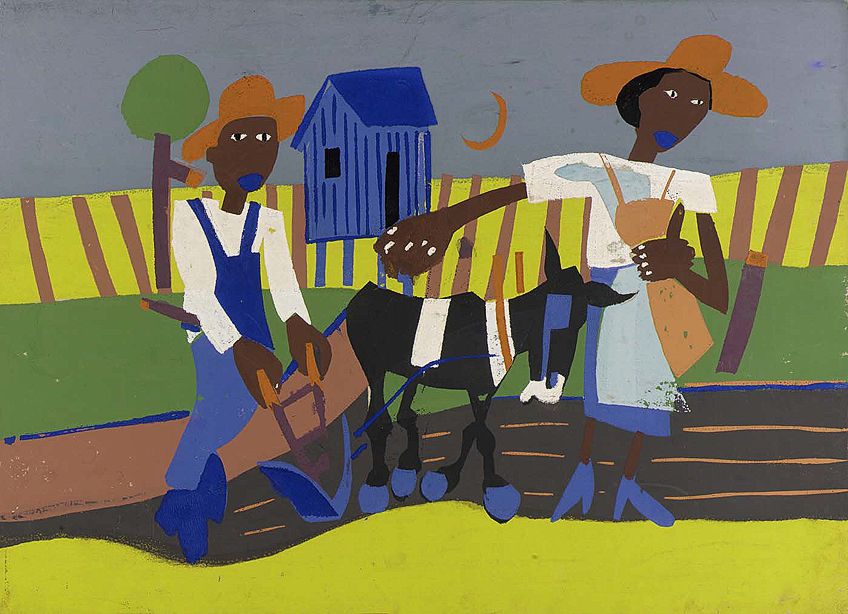 Sowing (1939-1940) by William H. Johnson, screenprint on newspaper; William H. Johnson, Public domain, via Wikimedia Commons
Sowing (1939-1940) by William H. Johnson, screenprint on newspaper; William H. Johnson, Public domain, via Wikimedia Commons
It was a buzzing cultural awakening in Harlem, and it countered and questioned the throes of oppression felt from racism, slavery, and racial injustices, inequalities, and stereotypical perspectives. This cultural awakening was given life through the visual arts. Decades later, we still witness the resurgence of a new modern African American life in Harlem.
The Harlem Renaissance artists all participated in an interdisciplinary way, exploring and experimenting with unlike themes, influences, and perspectives in their art. It was too avant-garde in its style as artists combined unlike genres of art, such as, antiquity, modernism, realism, and African art.
Works Progress Administration (WPA) and the Harlem Artist's Order
Because the Harlem Renaissance timeline fell along the aforementioned time equally the Great Depression, many people, including artists, were not able to find piece of work. The Works Progress Administration (WPA) was founded by President Franklin Delano Roosevelt in the 1930s and provided jobs for unemployed Americans.
One of the projects related to the WPA was the Federal Arts Project, through which thousands of artists were given fiscal stipends. The Harlem Renaissance artists were a part of the FAP and produced murals, sculptures, posters, and photographs for many public buildings like libraries, hospitals, theaters, and museums.
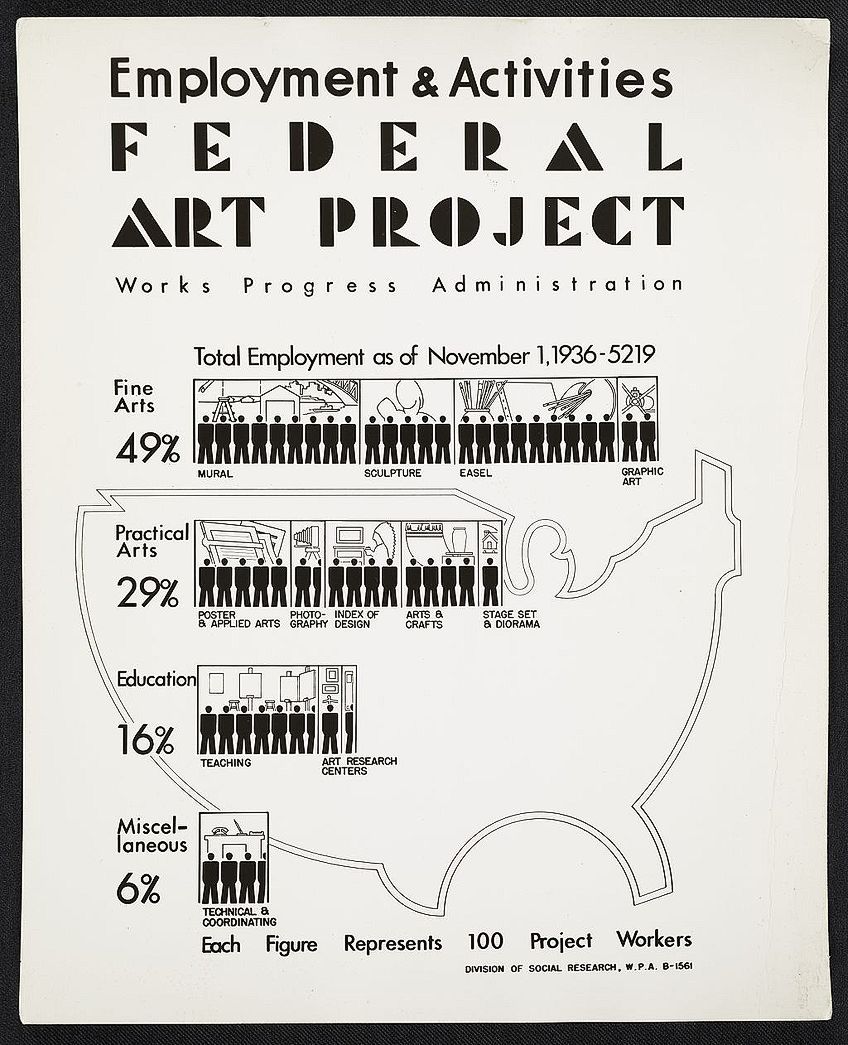 An employment and activities affiche for the WPA's Federal Art Project, 1936;Athenaeum of American Art, Public domain, via Wikimedia Commons
An employment and activities affiche for the WPA's Federal Art Project, 1936;Athenaeum of American Art, Public domain, via Wikimedia Commons
They were employed, so to say, as artists to uplift public spaces with new artworks. This gave everyone a renewed sense of hope during difficult economic times. Many artistic community centers and art schools opened to give artists the opportunities to work.
I of the more famous schools included the Harlem Artist's Order, which was co-founded in 1935 by Harlem Renaissance artists Augusta Barbarous, Charles Alston, and Elba Lightfoot.
This as well pushed the Federal Arts Project to give more opportunities to African American artists. In 1937, the WPA as well funded the new Harlem Community Art Center, which was created by the Harlem Artist's Society. It is as well important to annotation that Augusta Savage was a leading artist and founder of the Barbarous Schoolhouse of Arts and Crafts in 1932. She taught many Harlem Renaissance artists and sought to educate and train young artists likewise as to cultivate a deeper connection and sense of customs inside the Harlem fine art culture.
Major Harlem Renaissance Artists
While in that location were hundreds of Harlem Renaissance artists inside many disciplines, below we look at some of the famous artists from the fourth dimension. Some were painters, photographers, and sculptors, among other artistic disciplines.
James Van Der Zee (1886 – 1983)
James Van Der Zee was a photographer during the Harlem Renaissance period, born in Massachusetts. He was well-known for producing visual documentary records of the African American middle classes in New York and their lifestyles. He besides opened a photography studio chosen the Guarantee Photograph Studio.
Some of his photographs include Evening Attire (1922) and Couple in Raccoon Coats (1932), amongst many others. When we expect at Couple in Raccoon Coats as an example, Van Der Zee photographed an African American couple by their motorcar, which is a Cadillac roadster. The homo is sitting in the automobile while the woman stands next to him.
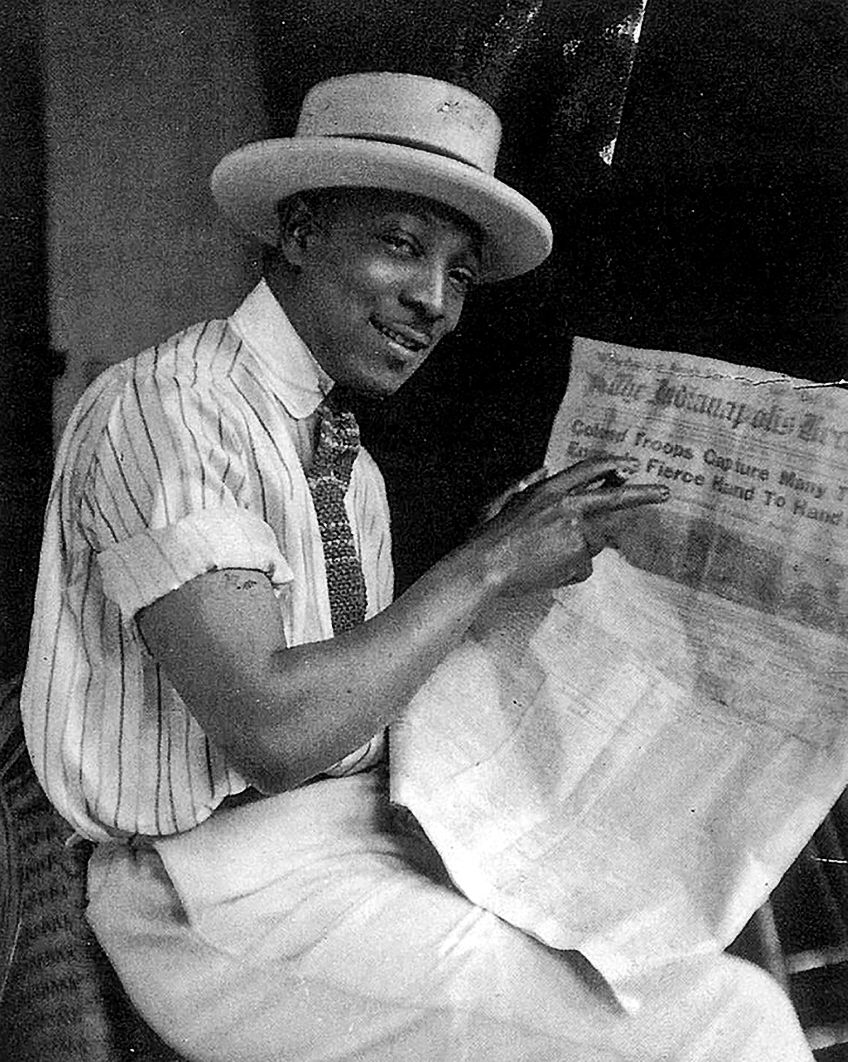 Self portrait of James Van Der Zee, taken in 1918; James Van Der Zee, Public domain, via Wikimedia Commons
Self portrait of James Van Der Zee, taken in 1918; James Van Der Zee, Public domain, via Wikimedia Commons
The couple appears relaxed and stylish, both wearing raccoon coats. Furthermore, Van Der Zee touches on many stereotypes in this photograph and perceptions related to how African Americans lived. The raccoon coat was a prominent fashionable item, especially amidst the younger generation, but here the artist portrays both the man and woman adorning this item without any worry about who should vesture it.
Van Der Zee took photographs in a wide diversity of settings, such every bit community-based events, weddings, funerals, and portraits of families. He captured the hearts of many in his photographs, simply an important point to remember is that he became an observer during a time of great modify and innovation culturally, racially, and societally.
Augusta Savage (1892 – 1962)
Born in Green Cove Springs, Florida, Augusta Christine Fells Savage was a prominent sculptor (famous for her portrait sculptors) during the Harlem Renaissance menstruation. What made her a leading figure within this motility was the fact that she was as well an fine art teacher and the art director of the customs-based Harlem Customs Art Heart.
In 1934, equally the first African American, she was chosen as part of the National Clan of Women Painters and Sculptors.
Savage also opened her ain fine art school chosen the Savage Studio of Arts and Crafts. Here she taught and created opportunities for aspiring artists who were interested in dissimilar artistic modalities like drawing, painting, and sculpting. Many well-known Harlem Renaissance artists emerged from her school, including Jacob Lawrence and Norman Lewis, as well as the notable public effigy in the Civil Rights Movement and children's education, Kenneth B. Clark, among many others. This fine art school eventually developed into the abovementioned Harlem Customs Art Middle.
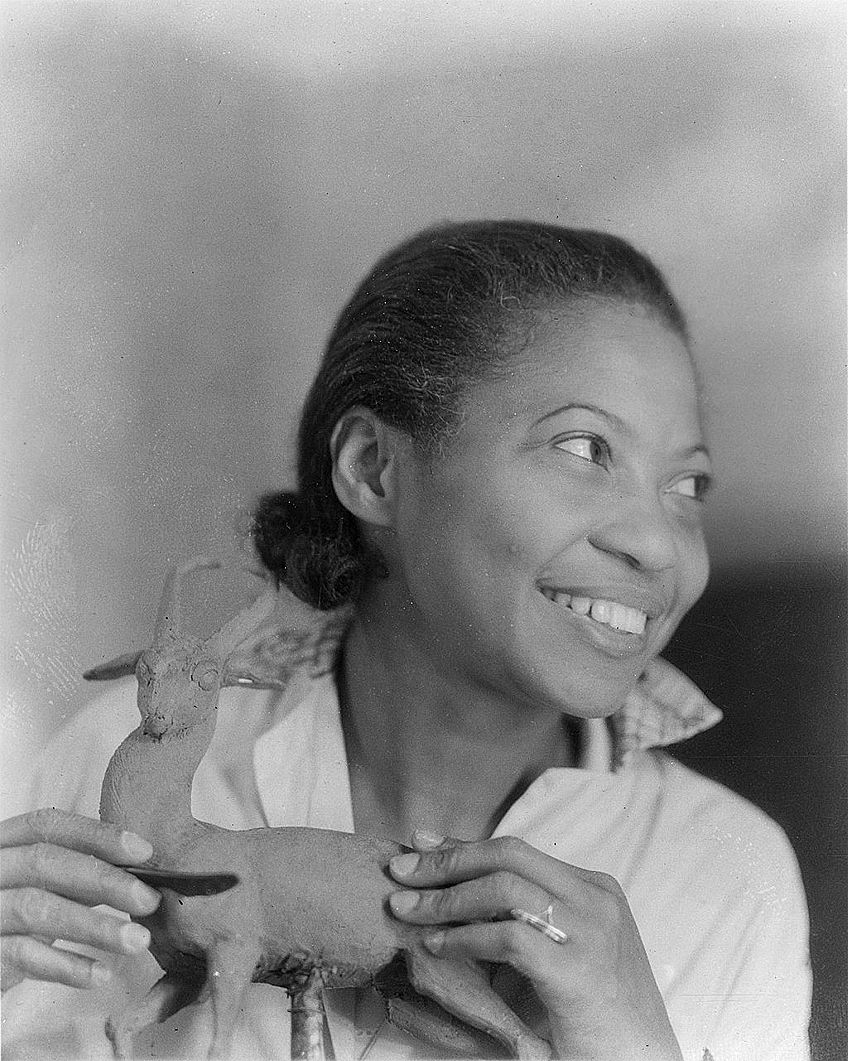 A photo of Augusta Savage, between 1935 and 1947; US Gov., Public domain, via Wikimedia Eatables
A photo of Augusta Savage, between 1935 and 1947; US Gov., Public domain, via Wikimedia Eatables
Some of Savage's notable artworks include Gamin (c. 1929), Gwendolyn Knight (1934 to 1935), Harlem Girl (1935), The Diving Male child (1939), Portrait Head of John Henry (1949), Young Boy (1940 to 1942), and The Harp (originally Lift Every Voice and Sing) (1939).
One of her famous commissioned artworks, a sixteen-foot plaster sculpture, was initially titled Lift Every Voice and Sing, named after a vocal by James Weldon Johnson, but it was later retitled to The Harp by the World's Off-white, where it was beingness exhibited.
It depicts 12 elongated African American singers continuing behind the other, each with their arms folded behind their backs.
The figures condign smaller and smaller, with the last four figures held in an open hand. This open up hand extends into an arm, which becomes the base to which all 12 figures seem to be attached. In front of the 12 singers is a figure of a man kneeling on his right knee and arms outstretched in front of him, giving the sense of receptivity and calm surrender. The singing figures behind him announced like a choir and the whole sculpture is in the shape of a harp. Furthermore, the figures are wearing long robes, which fold and fall into neat, symmetrically elongated lines, giving the impression of harp strings.
This slice was eventually destroyed, and Savage was not able to cast it in bronze. This was a popular sculpture during the World's Fair and reported to have been role of the most photographed sculptures. Information technology also featured alongside artworks by Salvador Dalí and Willem de Kooning.
Another example by Savage is Gamin, the bust of a streetwise boy, which is indicated past the inscription at the base of operations of the bust. Information technology is reported the boy who modeled for this bust was Savage's nephew, Ellis Ford.
This was also one of Savage'due south more famous sculptures, which was emulated further into a life-sized slice and other smaller pieces.
The boy depicted is an African American youth, or gamin, which refers to a boy that frequents the streets, otherwise chosen a "street urchin". It suggests someone in poverty, which is emphasized by the boy'southward crinkled shirt and his cap (known as a bebop cap), which was commonly worn by immature people who worked or dropped off newspapers.
What adds to the emotional intensity of the bust is the tilt of the boy's head to the right. His facial expression is also quite subdued and sobering. He does not give the idea of being happy – in fact, he appears unemotional, like someone who has endured hardships and is growing up too fast.
When nosotros look at Vicious's sculptures, the important question of "what did Harlem Renaissance artists express through sculpture?" is undoubtedly answered by her unique rendering of subject matter closely tied to what was at the eye of Harlem art: expressing the poignant African American journey and culture.
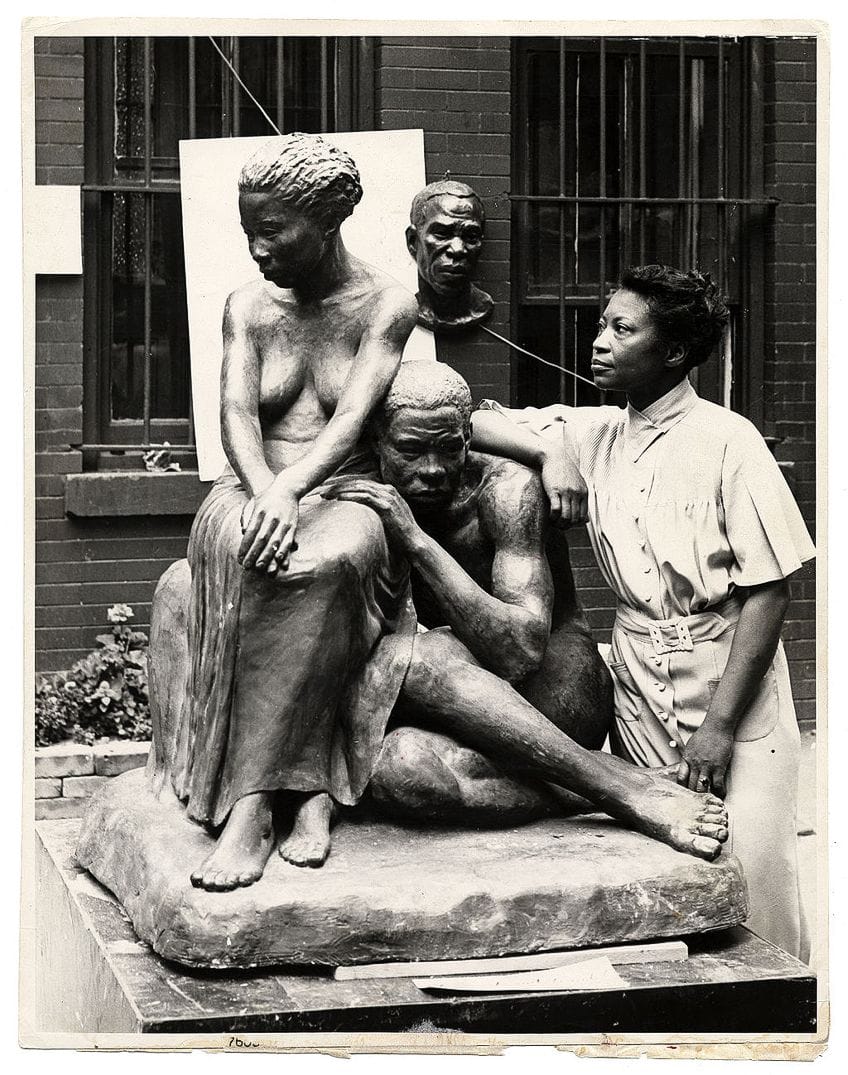 Augusta Savage posing with her sculpture Realization, created as function of the Works Progress Assistants's Federal Fine art Project, photo taken by Andrew Herman, c. 1938;Athenaeum of American Fine art, Public domain, via Wikimedia Commons
Augusta Savage posing with her sculpture Realization, created as function of the Works Progress Assistants's Federal Fine art Project, photo taken by Andrew Herman, c. 1938;Athenaeum of American Fine art, Public domain, via Wikimedia Commons
Aaron Douglas (1899 – 1979)
Born in Topeka, Kansas, Aaron Douglas was known as the "Father of African American Art". He was a role of the Harlem Artist's Guild and was also involved in establishing Fisk University'due south Art Department. He inspired and taught many young aspiring artists and was an influential effigy in Harlem Renaissance painting.
Some of the characteristics of Aaron's works include African American themes that appear Cubic-like. In fact, the artist was influenced by art movements similar Cubism.
Some of his earlier works were also influenced by modern art movements like Art Deco and Art Nouveau, such as his slice, Sahdji (Tribal Women) (1925). The artist was besides influenced by African art, especially West African art and the masks and sculptures from regions like Republic of benin and Senegal.
He used various shapes and circles to inform his compositions, which also created an boosted dynamism, although there was a stylistic ii-dimensionality to the overall advent of the works. His colors were frequently more subdued, and some words that describe his works include "figurative" and "decorative". Some of Douglas' other works include The Judgement Solar day (1927), Harriet Tubman (1931), The Negro in an African Setting (1934), An Idyll of the Deep South (1934), Disobedience (1972).
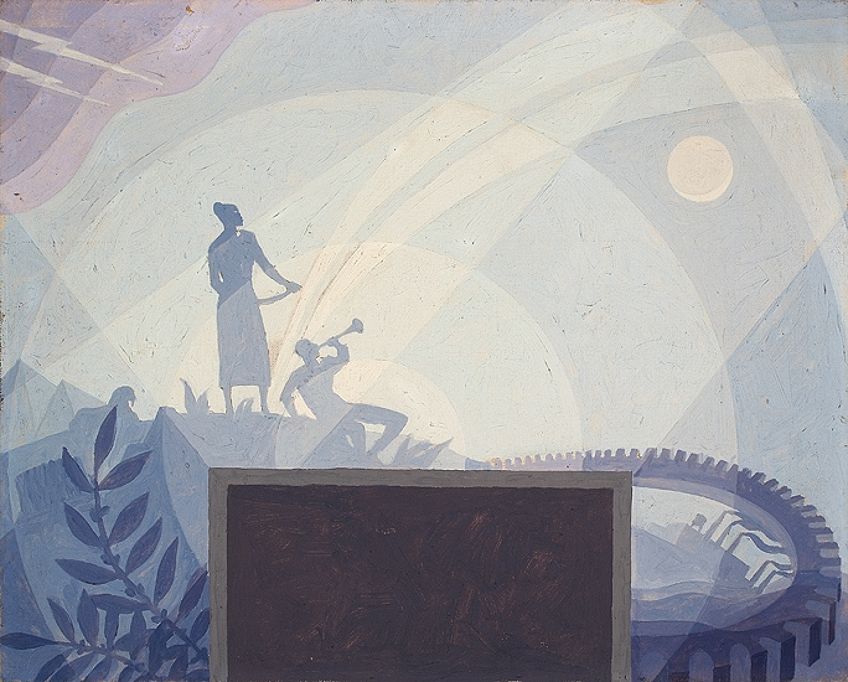 Study for Landscape (1963) by Aaron Douglas;Delaware Fine art Museum, CC Past-SA three.0, via Wikimedia Commons
Study for Landscape (1963) by Aaron Douglas;Delaware Fine art Museum, CC Past-SA three.0, via Wikimedia Commons
When we expect at Disobedience, ane of the artist'due south later works, we notice a similarity to his earlier-mentioned work Sahdji (Tribal Women). Both appear in a characteristic decorative composition; we see the familiar round and athwart shapes and stylized portrayal of figures. Both compositions too appear black and white in the colour scheme.
In Sahdji, the central effigy is a female. Nosotros discover the background (or landscape) depicts geometric pyramidal mountains with a quarter of a sun peeping out of the top left corner of the composition, its streaming rays delineated by thick wavy curls of lines.
In Defiance, the central figure is a male, more specifically, Brutus Jones from Eugene O'Neill's play Emperor Jones(1920). We notice that the landscape depicts various geometric forms of foliage. Furthermore, at that place is a confrontational feeling in the way the Jones character stands with his two feet in an farthermost version of a duck-footed stance.
The limerick is enlivened by the interaction of different shapes and lines.
We see the central figure standing on black wavy lines, suggesting h2o with two fish taking on both the black and white colors from the palette scheme, as though they were compositional chameleons. Furthermore, the leaf surrounding Jones appears to be a jungle setting, encroaching on him equally he moves forward. The whip in his right hand folds over into the leafage behind him and joins with the stylistic patterning of colors from the leaves – over again. almost similar a compositional chameleon.
Beauford Delaney (1901 – 1979)
Born in Knoxville, Tennessee, Beauford Delaney was a prominent Harlem Renaissance artist, just his work too went alongside that of Abstract Expressionism. During Delaney'south later years as an artist, there was influence from the art movements Impressionism and Fauvism. He was specially influenced by the works of Vincent van Gogh and focused on depicting the nature of light and color in his compositions.
Delaney lived in Paris in his later years, and equally a Harlem Renaissance creative person too as a gay African American, he was non received as avidly every bit other artists. However, his work still left a mark on many later his death. He was also seen as a mettlesome human being later having struggled with many challenges.
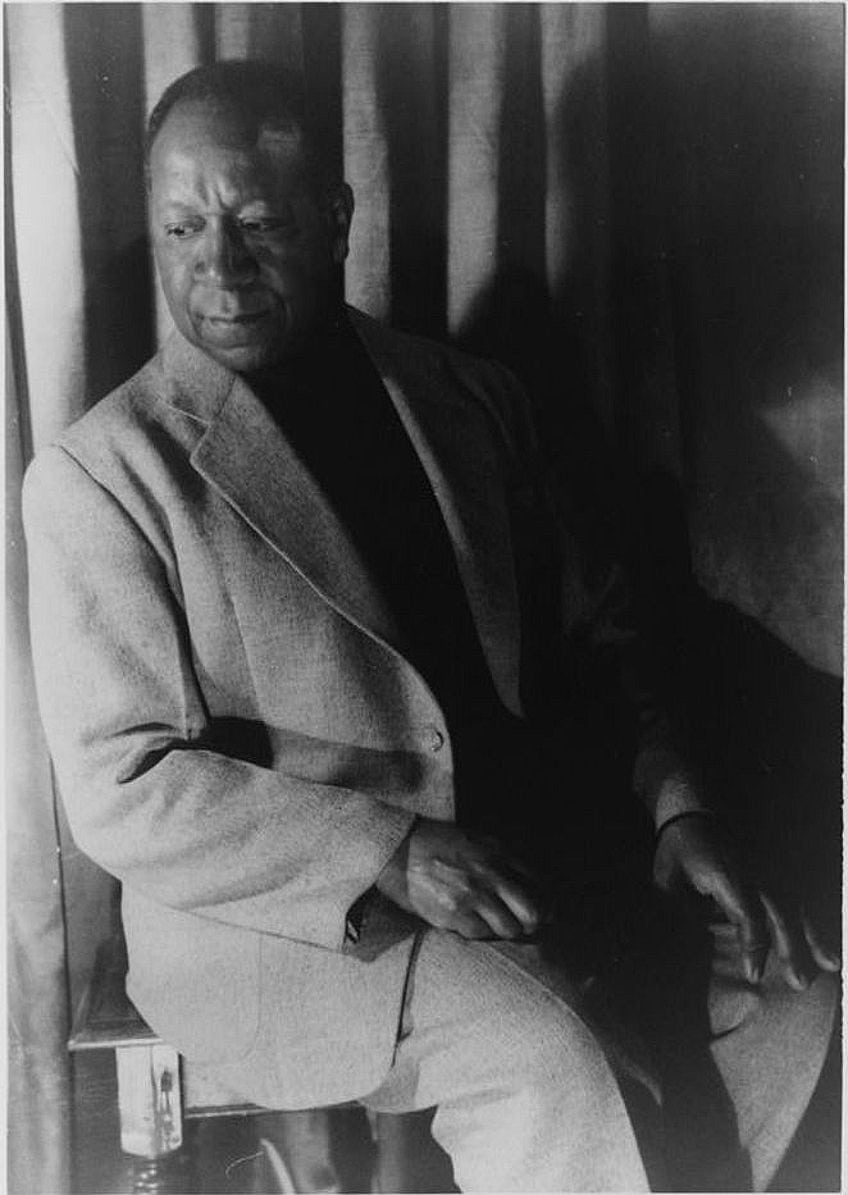 Portrait of American artist Beauford Delaney (1901–1979) by Carl Van Vechten, 1953; Carl Van Vechten, Public domain, via Wikimedia Eatables
Portrait of American artist Beauford Delaney (1901–1979) by Carl Van Vechten, 1953; Carl Van Vechten, Public domain, via Wikimedia Eatables
Some of his famous artworks include The Burning Bush (1941), Jazz Quartet (1946), Tin Burn in the Park (1946), Portrait of James Baldwin (1955), and the Portrait of Ella Fitzgerald (1968). Delaney's work includes a mix between realism and figurative expressions of deeper meanings.
There is also a trend towards the more spiritual aspects in many of Delaney'south works.
For instance, in The Burning Bush, an before work, Delaney incorporates biblical significance with a large literal and figurative fire taking over most of the limerick, particularly infiltrating the sky. There is also a vast expanse of country beyond the fire and what appears to exist an bounding main.
The colors utilized by Delaney are earthy in their tones: In the foreground, we see subdued green, xanthous, orangish, and patches of black, and in the background, we encounter the low-cal blue and white from the sky. Nosotros also notice a thicker application of pigment, which gives the limerick more expressive impetus.
William H. Johnson (1901 – 1970)
Built-in in South Carolina, William Johnson was a painter known for having realism, expressionism, and Folk art as his dominant painting styles. He was besides a teacher at the Harlem Customs Art Center. He produced thousands of artworks like paintings, drawings, watercolors, and prints, which were donated to the Smithsonian American Art Museum.
Some examples of his works include Blind Vocalist (1941), Going to Church building (1940 to 1941), Street Musicians (1939 to 1940), Sowing (1940), and Three Friends (1944). In the screen impress, Blind Vocalist, we find 2 happy musicians: a adult female playing the guitar to the right and a man, who is a blind singer, standing to the left adjacent to her.
 Blind Singer (c. 1939-1940) by William H. Johnson, serigraph on paper;William H. Johnson, Public domain, via Wikimedia Commons
Blind Singer (c. 1939-1940) by William H. Johnson, serigraph on paper;William H. Johnson, Public domain, via Wikimedia Commons
Nosotros meet the characteristic Folk-art mode in the composition of the two figures. The work is besides described as having a primitive appearance due to the characteristics of African art. In that location is likewise an angularity nearly their forms, which adds a dynamic effect.
Furthermore, in that location is a simplicity about their forms and the various shapes surrounding them, such equally their shoes and the guitar. Their bodies are likewise simplified and unrealistic in proportion, which is evident in their legs and enlarged hands, but this was a part of the artist's expressionistic style. For Johnson, screen printing became a dominant course of making art, and in his other works mentioned above, we volition notice that his mode depicts more than simplified forms, showing his involvement in the archaic style.
He is quoted as having said, "My aim is to express in a natural fashion what I feel, what is in me, both rhythmically and spiritually, all that which in time has been saved up in my family of primitiveness and tradition, and which is at present full-bodied in me."
Jacob Lawrence (1917 – 2000)
Built-in in Atlantic Urban center, New Jersey, Jacob Armstead Lawrence created compositions primarily with the historical field of study matter and the everyday experiences of African Americans. His works were also characterized by a stylistic print-like quality – the artist intentionally utilized elements from print to include more realistic effects. There are also angular and abstruse-like qualities inherent in his figures.
Some of his artworks include various series to portray narratives, for example, The Frederick Douglas Serial (1938 to 1939), The Migration of the Negro series (1940 to 1941), and the Infirmary Series (1950). Specific examples from these series include Console 22 from The Migration of the Negro series and Sedation from the Hospital Series. In Console 22 we notice three men with their backs facing u.s., golden handcuffs link them together. They stand with their heads appearing bowed, in a seemingly submissive posture.
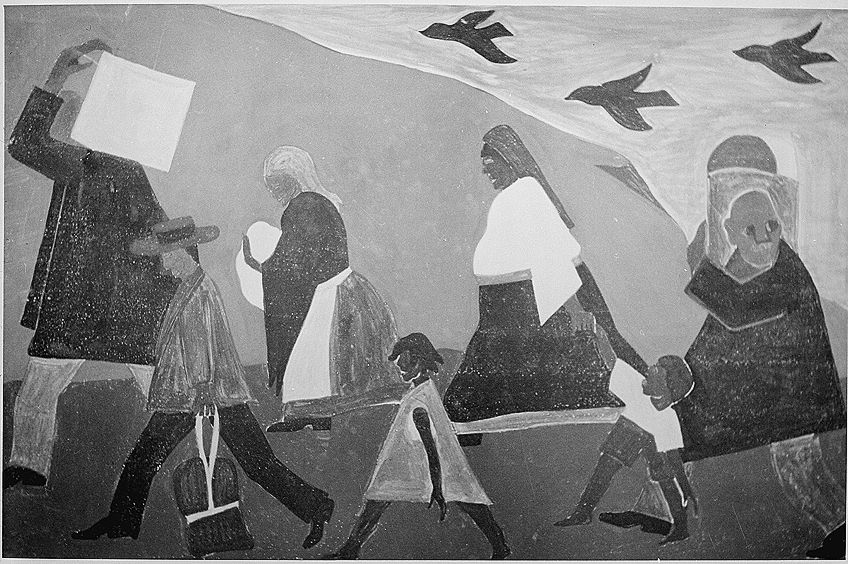 A panel from Jacob Lawrence's Migration of the Negro series, 1941;National Athenaeum at Higher Park, Public domain, via Wikimedia Eatables
A panel from Jacob Lawrence's Migration of the Negro series, 1941;National Athenaeum at Higher Park, Public domain, via Wikimedia Eatables
In front of them is a wall with a long row of confined, suggesting that they are in prison. Both this painting and series explore the lives of African Americans during the times they endured enslavement and imprisonment before the Migration era. Stylistically, nosotros notice a subdued monochromatic color palette with a play on the lines in the vertical confined and the vertical stripes on the figure's pants on the right.
The dark-green stripes almost intermission the monotonous colour scheme from the rest of the limerick.
Sedation shows what appears to be vii figures standing around an enclosed space with blueish, yellow, and red pills on a white surface, which appears to exist a white linen fabric. The figures all await eerily and vacantly at the pills, near as if they are simply out of reach, which is causing them to appear even more downtrodden.
The way Lawrence depicted the figures also emphasizes the eeriness of the stark reality of existence in a mental institution and being a patient within. The figures all appear clad in their pajamas and robes, standing closely next to one another with no spaces between them, which farther emphasizes a sense of anxiousness to get to the pills in front of them.
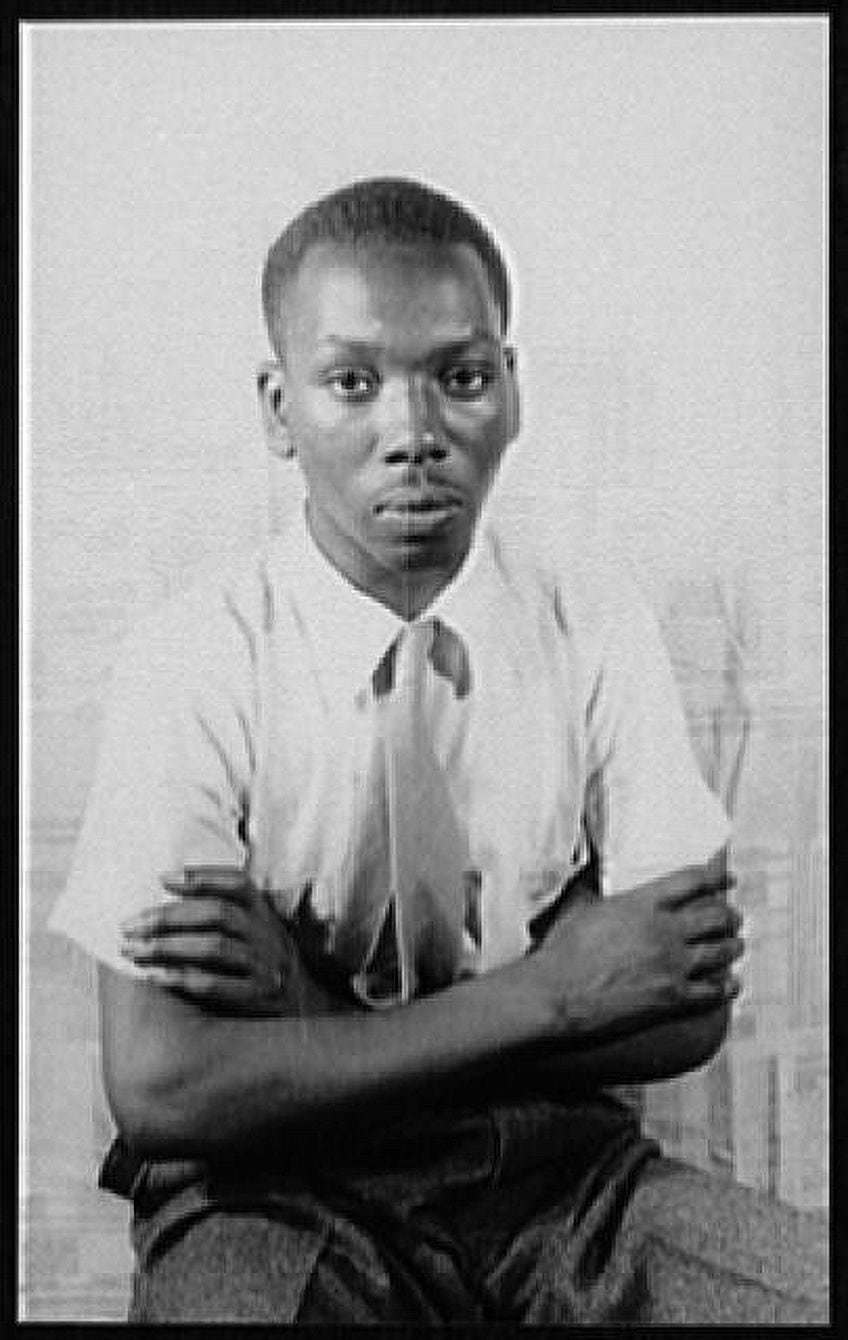 Portrait of Jacob Lawrence, 1941;Carl Van Vechten, Public domain, via Wikimedia Commons
Portrait of Jacob Lawrence, 1941;Carl Van Vechten, Public domain, via Wikimedia Commons
Lawrence depicted the figures in subdued colors, where the colour palette consists mostly of off-greens and some brighter dejection in-between. The groundwork appears kaleidoscopic in its utilize of geometric blue, xanthous, black, and grey-chocolate-brown shapes.
The limerick shows an intermingling of a somewhat depressing and ambivalent spectrum of shapes and colors – a direct portrayal of what it must feel like being in the state we see portrayed past the figures.
The creative person had first-paw feel of what it was like in a psychiatric ward as he admitted himself for a year in the Hillside Hospital located in Queens. This specific piece was done to explore the oftentimes cryptic human relationship between mentally ill patients and their intake of medication, and whether information technology is the medication that entraps them farther in the mental institution.
This Harlem Renaissance painting was markedly dissimilar from Lawrence's other paintings, which depicted figures related with historical significance. The figures in this serial are without hope and resigned to their fates. The artists likewise delved strongly into the recesses of psychological issues. Other notable works by Jacob Lawrence include This is Harlem (1943), Victory (1947), Two Rebels (1963), and The Builders (1980).
More Harlem Renaissance Artists
While the above-mentioned list of Harlem Renaissance artists includes of import figures of the time, there were many more talented artists from different disciplines who created non only paintings, but photographs, sculptures, films, and written works.
Some of the other artists worth mentioning are Archibald John Motley Jr., Loïs Mailou Jones, Richmond Barthé, and Langston Hughes, the latter of whom was a famous Harlem Renaissance poet and co-founder of the Fire!! Magazine, a Harlem Renaissance publication.
Other well-known photographers were James Latimer Allen, Roy DeCarava, and Oscar Micheaux, who was a film director and producer, having created Homesteader (1919) and Within Our Gates (1920) among more than 40 other films.
Other artists include Meta Vaux Warrick Fuller, who was an early on Harlem Renaissance artist. Her extensive studies in Paris led her to meet W.Eastward.B. Du Bois and the well-known sculptor, Auguste Rodin, who mentored her in creating sculptures with inherent realism. She likewise incorporated an Egyptian way in her sculptures. Some of her famous works include Federal democratic republic of ethiopia Awakening (1921).
 Photograph of a small maquette of Ethiopia Awakening by Meta Warrick Fuller, c. 1921; Photographer not credited. Published in Robert T. Kerlin, Negro Poets and their Poems (Washington, DC: Associated Publishers, Inc., 1923)., Public domain, via Wikimedia Eatables
Photograph of a small maquette of Ethiopia Awakening by Meta Warrick Fuller, c. 1921; Photographer not credited. Published in Robert T. Kerlin, Negro Poets and their Poems (Washington, DC: Associated Publishers, Inc., 1923)., Public domain, via Wikimedia Eatables
The African American Legacy
The Harlem Renaissance reached its endpoint betwixt the 1930s and 1940s. While it may have concluded as a motion, it certainly lived on in many second-generation artists. It also paved the mode for many female artists to express their unique gifts and abilities. People like Augusta Savage inspired and led the style for what women are at present able to do.
In fact, it was non only women that were inspired, only also whatever communities that had faced generations of oppression. They were given an outlet to express their skills and talents, whether it was sculpture, painting, photography, writing, making music, or acting in theater.
The Harlem Renaissance period also adult new philosophical ideals like Négritude, which was a new cultural move started by the French Aimé Césaire, Leon Damas, and Léopold Senghor. They also influenced other philosophers similar Jean-Paul Sartre, who was an important figure in French philosophical idea as well as Marxism.
Harlem Renaissance artwork contributed to the growth and development of African American art for decades to come up. It influenced artists of all walks of life and backgrounds to create, produce, and limited the heritage, traumas, and unique abilities within them. This motion grew across Harlem and inspired those on the fringes of society to come forward and unashamedly show the world who they were.
Oft Asked Questions
When Was the Harlem Renaissance?
The Harlem Renaissance started during the late 1910s and early 1920s in New York City, around the end of World State of war I, and lasted until the 1940s, around Earth War II. There are other sources that study its ending engagement around 1929, during the time of the Stock Market Crash that led to the Great Depression in 1930, which led many people to lose their livelihoods.
How Did the Harlem Renaissance Offset?
The Harlem Renaissance's origins prevarication in the events earlier the Great Migration, which is dated to around 1916 in Southern America. Due to slavery, lynching, and societal, cultural, and racial oppression, millions of black Americans migrated from places like Mississippi, South Carolina, and Louisiana to Northern American cities like New York, Los Angeles, and Washington D.C (among others), where they had better treatment and more opportunities.
What Was the Harlem Renaissance?
The Harlem Renaissance was a revival of cultural trends in the Harlem neighborhood of New York City. It was primarily a community of African American artists who questioned the oppression felt from racism, slavery, and racial injustices, inequalities, and stereotypical perspectives from issues like white supremacism.
What Was Harlem Renaissance Art?
The cultural awakening in Harlem, chosen the Harlem Renaissance, was expressed through the visual arts. There were artists from a variety of disciplines like theater and moving picture, literature, and music like Jazz. Visual arts included paintings, sculptures, printmaking, and illustrations.
What Were the Characteristics of Harlem Renaissance Fine art?
At that place was a diverse group of people within the Harlem community, only some of the main characteristics were inspired by the modernist art movements that incorporated more abstractions and figurative portrayals of compositions. There was also an influence from African art, for example, African masks and motifs. Overall, the primary characteristics of Harlem Renaissance Art were cocky-expression and breaking the boundaries between prejudice and identity.
What Did Harlem Renaissance Artists Express Through Sculpture?
Harlem Renaissance artists used sculpture to limited the inherent ideals of the Harlem Renaissance, which were to limited their solidarity and uniqueness every bit a community and an African American culture. They likewise used sculpture to illustrate and embody their skills and widely learned skills, equally well as the everyday lifestyles and occurrences of people.
Belum ada Komentar untuk "The Harlem Renaissance Art the Harlem Renaissance Art Jazz"
Posting Komentar